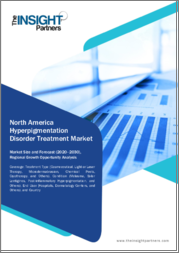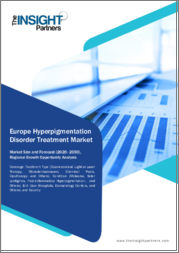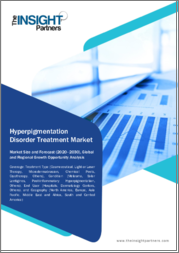
|
시장보고서
상품코드
1487678
세계의 색소침착증 치료 시장 : 치료 유형별, 질환 유형별 예측(2024-2032년)Pigmentation Disorder Treatment Market - By Treatment Type, Type of Disorder - Global Forecast 2024 - 2032 |
||||||
색소 침착증 치료 시장 규모는 2024년부터 2032년까지 연평균 5.8%의 성장률을 나타낼 것으로 예상되며, 색소 침착증과 피부 건강에 미치는 영향에 대한 전 세계 인구의 인식 증가가 그 원동력이 될 것으로 보입니다.
개인의 외모에 대한 인식이 높아지고 피부 문제를 해결하고자 하는 욕구가 증가함에 따라 고급 색소 침착 치료에 대한 수요가 증가하고 있습니다. 또한 피부과학 연구와 의료 기술의 발전은 혁신적인 치료 옵션의 개발로 이어졌습니다.
장수화와 자외선 등 환경적 요인에 대한 노출이 증가함에 따라 간반, 색소침착, 백반증 등 색소질환의 유병률은 더욱 증가하고 있으며, Global Vitiligo Foundation에 따르면 전 세계적으로 7,000만 명이 백반증을 앓고 있으며, 인종, 민족, 성별에 따른 차이는 없습니다. 백반증 환자의 약 20-35%는 어린이입니다. 이에 따라 백반증을 관리하기 위한 안전하고 효과적이며 최소 침습적인 치료 옵션에 대한 수요가 증가하고 있습니다. 소셜 미디어와 미용 기준의 영향력이 커지면서 완벽한 피부에 대한 욕구가 높아져 색소 침착 치료에 대한 수요가 더욱 증가하고 있습니다.
치료 유형별로는 색소침착증 치료 시술 분야 시장 규모는 2032년까지 연평균 5.5%의 성장률을 나타낼 것으로 예측됩니다. 이는 색소질환을 효과적으로 치료하기 위한 고급 피부과 시술에 대한 수요가 증가했기 때문입니다. 레이저 치료, 화학적 박피술, 미세 박피술, IPL(Intense Pulsed Light) 치료와 같은 시술은 다양한 색소 침착 문제에 대한 정확한 솔루션을 제공합니다. 또한, 치료 기법과 기술의 발전으로 다운타임과 부작용을 최소화하면서 치료 결과를 개선하고 환자 만족도를 높이고 있습니다.
질환별로 보면, 색소 침착증 치료 시장의 색소 침착증 분야는 광범위한 유행과 소비자 인식 증가로 인해 2024년부터 2032년까지 연평균 5.7%의 성장률을 나타낼 것으로 추정됩니다. 햇볕, 호르몬 변화, 노화 등의 요인이 색소 침착의 발생에 기여함에 따라 이 흔한 피부 문제를 해결하는 효과적인 치료 옵션에 대한 수요가 증가하고 있습니다. 색소 침착에 특화된 치료법의 발전과 전문적인 피부 관리 서비스의 가용성이 증가함에 따라 이 분야의 성장에 힘을 실어주고 있습니다.
아시아태평양의 색소침착증 치료 산업은 2024년부터 2032년까지 연평균 6.4%로 급성장할 것으로 예상됩니다. 이러한 유병률 증가는 가처분 소득 증가와 피부 관리에 대한 인식 증가와 함께 효과적인 치료 옵션에 대한 수요를 촉진하고 있습니다. 첨단 피부과 시술 및 피부 관리 기술의 가용성 확대와 화장품 채택 증가는 아시아태평양 시장 성장을 더욱 촉진할 것으로 보입니다.
목차
제1장 조사 방법과 조사 범위
제2장 주요 요약
제3장 업계 인사이트
- 생태계 분석
- 업계에 대한 영향요인
- 성장 촉진요인
- 업계의 잠재적 리스크와 과제
- 성장 가능성 분석
- 규제 상황
- Porter's Five Forces 분석
- PESTEL 분석
제4장 경쟁 구도
- 서론
- 기업 매트릭스 분석
- 기업 점유율 분석
- 경쟁 포지셔닝 매트릭스
- 전략 대시보드
제5장 시장 추산·예측 : 치료 유형별(2018년-2032년)
- 주요 동향
- 의약품
- 유형별
- 투여 경로별
- 유통 경로별
- 시술
- 유형별
- 최종사용자별
제6장 시장 추산·예측 : 질환별(2018년-2032년)
- 주요 동향
- 색소 침착 저하
- 백반
- 백피증
- 기타
- 색소 침착 과잉
- 기미
- 흑자(Lentigines)
- 염증 후 색소 침착(PIH)
- 기타
제7장 시장 추산·주요 동향 예측 : 지역별(2018년-2032년)
- 주요 동향 : 지역별
- 북미
- 미국
- 캐나다
- 유럽
- 독일
- 영국
- 프랑스
- 스페인
- 이탈리아
- 기타 유럽
- 아시아태평양
- 일본
- 중국
- 인도
- 호주
- 기타 아시아태평양
- 라틴아메리카
- 브라질
- 멕시코
- 기타 라틴아메리카
- 중동 및 아프리카
- 남아프리카공화국
- 사우디아라비아
- 기타 중동 및 아프리카
제8장 기업 개요
- AbbVie Inc.
- Candela Corporation
- Cipher Pharmaceuticals Inc.
- Galderma
- GSK plc
- Incyte
- L'Oreal Paris
- Novartis AG
- Pfizer Inc.
- Pierre Fabre group
- Shiseido Company Limited
Pigmentation disorder treatment market size is likely to register 5.8% CAGR between 2024 to 2032, driven by the increasing awareness among the global population about pigmentation disorders and their impact on skin health. As individuals are becoming more conscious about their appearance and seeking to address skin concerns, the demand for advanced pigmentation treatments is on the rise. Additionally, advancements in dermatological research and medical technology have led to the development of innovative treatment options.
With increasing longevity and exposure to environmental factors like UV radiation, the prevalence of pigmentation disorders, such as melasma, hyperpigmentation, and vitiligo is further growing. As per Global Vitiligo Foundation, vitiligo affects 70 million people worldwide, with no barriers based on race, ethnicity, or gender. Around 20-35% of vitiligo patients are children. As a result, there is a growing demand for safe, effective, and minimally invasive treatment options to manage these conditions. The growing influence of social media and beauty standards has fueled the desire for flawless skin, further driving the demand for pigmentation treatments
The overall industry is segmented the into treatment type, type of disorder, and region.
Based on treatment type, the pigmentation disorder treatment market value from the procedures segment is anticipated to witness 5.5% CAGR through 2032. This is due to the increasing demand for advanced dermatological procedures aimed at addressing pigmentation disorders effectively. Procedures, such as laser therapy, chemical peels, microdermabrasion, and intense pulsed light (IPL) treatments offer targeted and precise solutions for various pigmentation concerns. Moreover, advancements in procedural techniques and technologies are improving treatment outcomes while minimizing downtime and side effects for enhancing patient satisfaction.
In terms of type of disorder, the hyperpigmentation segment in the pigmentation disorder treatment market is estimated to record 5.7% CAGR from 2024 to 2032, due to its widespread prevalence and increasing awareness among consumers. With factors, such as sun exposure, hormonal fluctuations, and aging contributing to the development of hyperpigmentation, there is a growing demand for effective treatment options to address this common skin concern. Advancements in treatment modalities tailored specifically for hyperpigmentation, along with the growing availability of professional skincare services are also favoring the segment growth.
Asia Pacific pigmentation disorder treatment industry size will witness rapid expansion at 6.4% CAGR between 2024-2032, attributed to the diverse population and varying climate conditions. This increased incidence, coupled with rising disposable incomes and growing awareness about skincare is fueling the demand for effective treatment options. The expanding availability of advanced dermatological procedures and skincare technologies along with the rising adoption of cosmeceuticals will further propel the market growth in the Asia Pacific.
Table of Contents
Chapter 1 Methodology & Scope
- 1.1 Market scope & definitions
- 1.2 Base estimates & calculations
- 1.3 Data collection
- 1.4 Forecast parameters
- 1.5 Data validation
- 1.6 Data sources
- 1.6.1 Primary
- 1.6.2 Secondary
- 1.6.2.1 Paid sources
- 1.6.2.2 Public sources
Chapter 2 Executive Summary
- 2.1 Industry 360 degree synopsis
Chapter 3 Industry Insights
- 3.1 Industry ecosystem analysis
- 3.2 Industry impact forces
- 3.2.1 Growth drivers
- 3.2.1.1 Growing adoption of advanced skin care procedures
- 3.2.1.2 Increasing prevalence of pigmentation disorders
- 3.2.1.3 Growing expenditure on dermatological treatments
- 3.2.1.4 Rising awareness regarding skin health among younger population
- 3.2.2 Industry pitfalls & challenges
- 3.2.2.1 High cost of cosmetic procedures
- 3.2.2.2 Lack of reimbursement policies
- 3.2.1 Growth drivers
- 3.3 Growth potential analysis
- 3.4 Regulatory landscape
- 3.5 Porter's analysis
- 3.5.1 Supplier power
- 3.5.2 Buyer power
- 3.5.3 Threat of new entrants
- 3.5.4 Threat of substitutes
- 3.5.5 Industry rivalry
- 3.6 PESTEL analysis
Chapter 4 Competitive Landscape, 2023
- 4.1 Introduction
- 4.2 Company matrix analysis
- 4.3 Company market share analysis
- 4.4 Competitive positioning matrix
- 4.5 Strategic dashboard
Chapter 5 Market Estimates and Forecast, By Treatment Type, 2018 - 2032 ($ Mn)
- 5.1 Key trends
- 5.2 Drugs
- 5.2.1 By type
- 5.2.1.1 Corticosteroids
- 5.2.1.2 Melanocyte-stimulating hormone
- 5.2.1.3 Other drugs
- 5.2.2 By route of administration
- 5.2.2.1 Oral
- 5.2.2.2 Topical
- 5.2.2.3 Other routes of administrations
- 5.2.3 By distribution channel
- 5.2.3.1 Hospital pharmacies
- 5.2.3.2 Retail pharmacies
- 5.2.3.3 Online pharmacies
- 5.2.1 By type
- 5.3 Procedures
- 5.3.1 By type
- 5.3.1.1 Laser treatment
- 5.3.1.2 Phototherapy
- 5.3.1.3 Dermabrasion
- 5.3.1.4 Other procedures
- 5.3.2 By end-user
- 5.3.2.1 Hospitals
- 5.3.2.2 Dermatology clinics
- 5.3.2.3 Aesthetic centers
- 5.3.2.4 Other end-users
- 5.3.1 By type
Chapter 6 Market Estimates and Forecast, By Type of Disorder, 2018 - 2032 ($ Mn)
- 6.1 Key trends
- 6.2 Hypopigmentation
- 6.2.1 Vitiligo
- 6.2.2 Albinism
- 6.2.3 Other hypopigmentations
- 6.3 Hyperpigmentation
- 6.3.1 Melasma
- 6.3.2 Lentigines
- 6.3.3 Post-inflammatory hyperpigmentation (PIH)
- 6.3.4 Other hyperpigmentations
Chapter 7 Market Estimates and Forecast, By Region, 2018 - 2032 ($ Mn)
- 7.1 Key trends, by region
- 7.2 North America
- 7.2.1 U.S.
- 7.2.2 Canada
- 7.3 Europe
- 7.3.1 Germany
- 7.3.2 UK
- 7.3.3 France
- 7.3.4 Spain
- 7.3.5 Italy
- 7.3.6 Rest of Europe
- 7.4 Asia Pacific
- 7.4.1 Japan
- 7.4.2 China
- 7.4.3 India
- 7.4.4 Australia
- 7.4.5 Rest of Asia Pacific
- 7.5 Latin America
- 7.5.1 Brazil
- 7.5.2 Mexico
- 7.5.3 Rest of Latin America
- 7.6 Middle East and Africa
- 7.6.1 South Africa
- 7.6.2 Saudi Arabia
- 7.6.3 Rest of Middle East and Africa
Chapter 8 Company Profiles
- 8.1 AbbVie Inc.
- 8.2 Candela Corporation
- 8.3 Cipher Pharmaceuticals Inc.
- 8.4 Galderma
- 8.5 GSK plc
- 8.6 Incyte
- 8.7 L'Oréal Paris
- 8.8 Novartis AG
- 8.9 Pfizer Inc.
- 8.10 Pierre Fabre group
- 8.11 Shiseido Company Limited


















